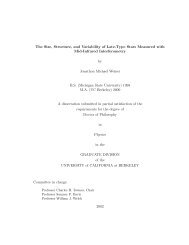Astro 160: The Physics of Stars
Astro 160: The Physics of Stars
Astro 160: The Physics of Stars
You also want an ePaper? Increase the reach of your titles
YUMPU automatically turns print PDFs into web optimized ePapers that Google loves.
We know thatwhereN 7 (t) = N 5(t) e λ5t − 1N 8 (t) e λ8t − 1 · N 6(t)N 5 (t) e λ5t − 1N 8 (t) e λ8t − 1 = constant• Given that the current ratio <strong>of</strong> naturraly occurring U 235 to U 238 is 0.0071, evaluate the gradient <strong>of</strong>the straight line for rock samples <strong>of</strong> age (a) 1 billion years, (b) 3 billion years and (c) 5 billion years.We know that the gradient <strong>of</strong> the straight line is just the constant in front <strong>of</strong> N 6 (t) so we just have to plugin numbers(a). t = 1 billion years.We know thatλ 5 ∼ 9.90 × 10 −10 yr −1 λ 8 ∼ 1.5 × 10 −10 yr −1given these and the fact that we know the ratio between U 235 and U 238 we can find the gradient, for 1bilion years we get0.0071 · eλ 5t − 1e λ 8t − 1 = 0.0715For 3 billion years we get0.0071 · eλ 5t − 1e λ 8t − 1 = .231and finally for 5 billion years we get0.0071 · eλ 5t − 1e λ 8t − 1 = .891Problem # 4 Radiative AtmospheresIn this problem we will solve for the structure <strong>of</strong> the outer part <strong>of</strong> a star assuming that energy istransported solely by radiative diffusion (which is not the case in the sun, but is the case in stars moremassive than the sun). <strong>The</strong> star has a mass M and a luminosity L. Assume that the luminosity and massare approximately constant at the large radii <strong>of</strong> interest, that gas pressure dominates, and that the opacity isdue to electron scattering. Do not assume that the atmosphere is thin (i.e even though M r ≈ constant = M,because rchanges, the gravitional acceleartion is not constant).Write down the equations for hydrostatic equlibrium and energy transport by radiative diffusion. Usethese to calculate dP rad /dP, the change in radiatio pressure with pressure in the atmosphere. What doesthis result imply for how the ratio <strong>of</strong> gas pressure to radiation pressure changes as a function <strong>of</strong> thedistance in the atmosphere? Show that your result for dP rad /dP implies that ρ ∝ T 3 and P ∝ ρ 4/3 forradiative atmospheres (in the language that we will use in the next week, this means that the radiative part<strong>of</strong> the star is an n=3 polytrope).since we know what the radiation pressure is we can find what the change is with respect to rP rad = 1 3 aT 4dP raddr= 1 3 a d dr (T 4 ) = 4 3 T 4 ∇T6












![Problem #1 [Structure Formation I: Radiation Era]](https://img.yumpu.com/37147371/1/190x245/problem-1-structure-formation-i-radiation-era.jpg?quality=85)



